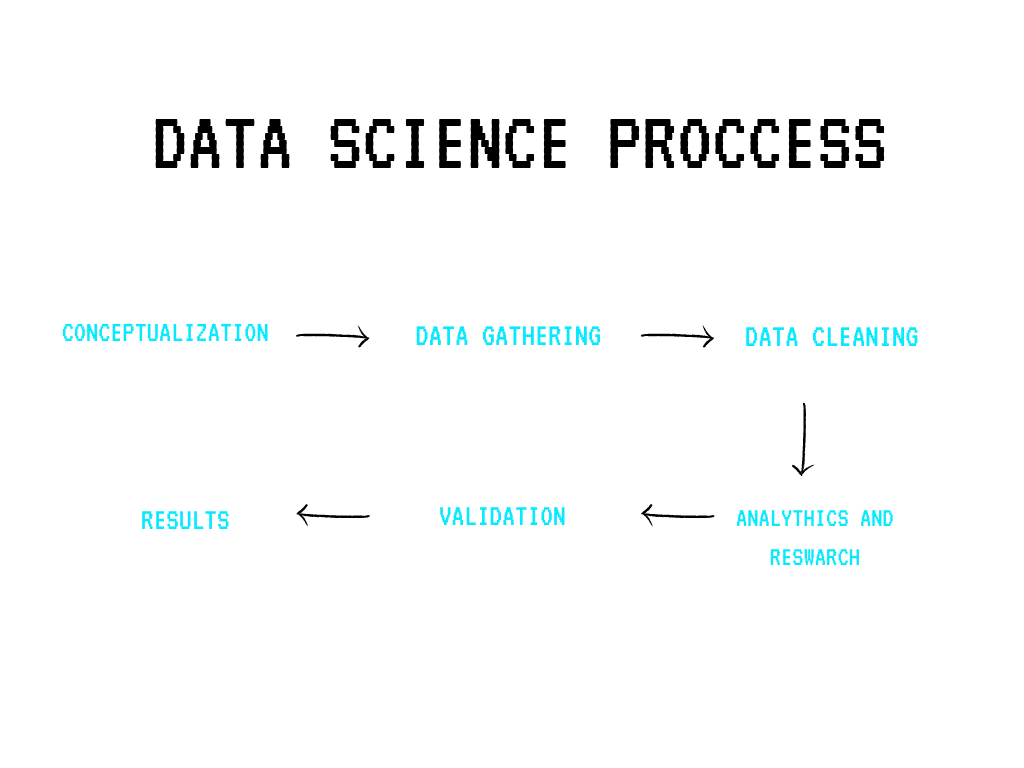Steps to Solve Data Science Projects
Whether it is governance, industrialization, tech, education, marketing etc., data plays an influential role in every social outcome. But just like minerals such as gold that are unusable in their raw state, data also needs to go through a refining process to become useful.
Large volumes of data are produced and extracted every day. According to recent reports, every one of us produces an average of 1.7 MB of data every second, which amounts to 1.145 trillion MB per day. This is quite a lot.
Data is important, but with the amount of data we churn out every day, it can become overwhelming to find the value point and utilize it, hence the importance of data science.
Data science is a sensitive subject because it determines the value point in every data and can also guide data-based executions. In simple terms, without data science, data will be of little-to-no value.
Organizations acknowledge the importance of data science; a Mckinsey survey revealed that 47 percent of companies admitted that data-driven decisions had sharpened their competitive edge. The problem, however, is that most organizations do not know how to wield data science effectively to extract and analyze useful data from the crowd.
In this guide, we shall outline important steps curated by various data science experts to solve data science projects and discuss how best to approach data science.
we’re sure you know what data science is, but before we go ahead, let’s have a quick recap of what data science is so that it all makes sense.
What is Data Science?
According to the IBM cloud education, Data science is an interdisciplinary approach to obtaining actionable insights from the massive and always increasing volumes of data. So a data scientist prepares data for analysis and processing, undertakes advanced data analysis, and presents the results to expose trends that enable stakeholders to make better and informed decisions.
From the foregoing, it is easy to assume that data science can be done by applying research skills; some people even believe that having programming skills is enough to handle data science projects. But these are all erroneous thoughts.

Here are practicable steps to handle data science projects.
Conceptualization
Every data science project begins with the conceptualization phase. This is where pertinent questions related to your objectives are asked, and expected results are determined. This is the foundation of your data science project, and some important aspects of the project, such as drawing a scope, are determined, even before any real action is taken.
In this stage, you determine the kind of data you need, the scope of data to be covered, how the data is meant to influence processes, etc. here is how you can approach the conceptualization phase.
- Identify challenges
Many businesses employ data science wrongly, they do it because it’s trending or because they think it would help their business, but they often forget it’s a real solution rather than a trending concept. Identifying real business problems that can be solved with data science enabled is the first step to getting it right. It helps you apply data science rightly and achieve great results.
- Review old and existing processes
There is no better way to begin a data science project than to old and existing processes and projects. This is especially for organizations that have applied data science in their operations in the past.
- Predict possible ROI
One of the best determinants of performance for a data science team is the ability to evaluate the probable business impact of a data science project.
- Identify and assemble experts and team members
Approaching a data science project requires the input of various experts, including data scientists, data analysts, etc. The first thing to do is to know which experts are needed and assemble them to begin planning.
Identifying and gathering data
This is one of the most important aspects of your data science project. Any error made in this stage can yield misleading results and nullify the purpose of the project.
First, you have to identify what kind of data you require before you begin the process of gathering and collating the identified data. Usually, data is obtained from multiple sources, and it may come in varying forms( texts, pictures, videos etc.). After identifying and collating data, the next step is data preparation.
The act of refining and processing raw data into meaningful attributes that can be used to analyze and construct prediction models is known as data preparation. This is a key stage that sometimes is tough to complete. It will consume a significant amount of your time.
Here are steps that can help you identify and gather data
- Data interpretation
Visualize your data and have a good understanding of its concept and form. Decide how it fits into the project and analyze it.
- Data cleaning
Ensure that the available data is properly refined and every extraneous element is extinguished.
- Deploying previous datasets
Considering the efforts and time it takes to prepare data, it becomes necessary that organizations store every dataset in a reusable manner. With this, data experts may save time by deploying previous data where applicable rather than going through the process of data preparation every time.
- Keep a record of downstream consumption of data
Collecting data can be a very expensive venture, and you may never know which data will be useful. So rather than blow resources and blindly pursue every data element within your reach, it is better to keep track of downstream data consumption unique to your industry and niche. This will better guide your data science projects and reduce data investment waste.
Research and experimentation
Sometimes, to get the best results, you may need to carry out extensive research and experiment with different algorithms to determine the ideal hyperparameter values that will give you the greatest results.
Key practices that will help you in this phase.
- Start simple
Resist the urge to use difficult models; you may end up complicating your job rather than getting results.
- Frequently share insights and results
Do not wait until the final results before you share progress. In data science, there can be various results in one project and before the final result. So always share any insights and do so as frequently as possible.
- Do not lose track of business KPIs
Data science teams can sometimes get distracted and forget to prioritize the business they’re seeking to influence in favor of a specific measure. While working on a data science project, ensure that the process and outcome reflect the business goals by aligning your business KPI with the data science project.
Verify all processes
This step requires a thorough verification of the entire data science project process. It goes beyond verifying the source code. Data parameters, forecast results, target output, accuracy should all be evaluated and verified. The aim is to ensure relative accuracy, get all the required approval, including any regulatory and compliance requirements.
Employ automated verification
While fully automated tools may not be a thing yet for data science testing, there are recurring steps in the verification process that can be automated. This will save time and allow human testers to focus on other important aspects.
You may consider cloud platforms
A Cloud platform is an operating system that provides on-demand computing services and resources over the internet, including storage, analytics, networking database etc. The computing capacity of cloud platforms can help you develop your algorithm with a lot of data and execute many tests in a limited time.
Results
At this stage, results are delivered and measured against projected outcomes. Here, you are no longer dealing with just mathematical expressions and figures but realistic statistics capable of influencing business decisions and outcomes. The results are sent to the appropriate quarters and deployed in the field.
Monitoring / Communication
It is important to actively monitor your data science projects even after delivering results. As data is constantly increasing and evolving, so should data-based decisions executions be regularly updated.
You can have alert systems, monitoring and tracking tools integrated so that you will always be informed of changes.
Finally, it is critical to convey your findings. A presentation, official report, or even a post can be used to do this. The point is that you communicate your findings as clearly as possible.
Conclusion
Every data science project requires a clearly drawn out and actionable process to ensure that the results are correct and valuable. Although most data science projects differ, the above guide is universal and can effectively help you solve any data science project.



